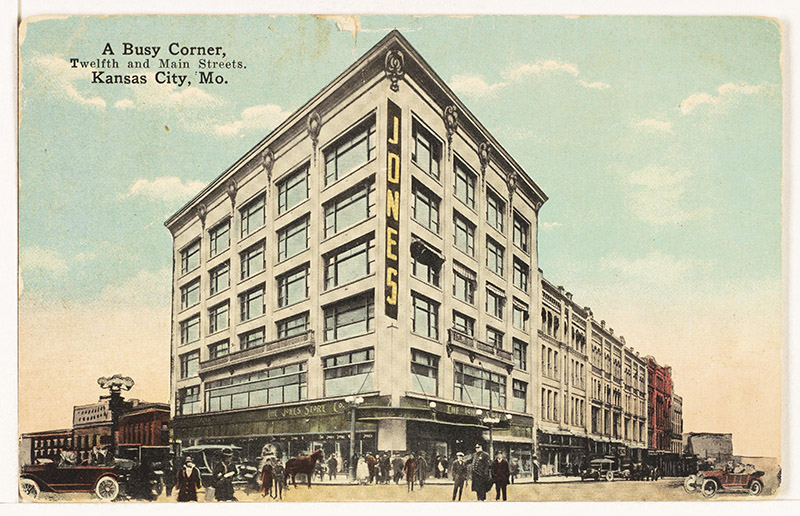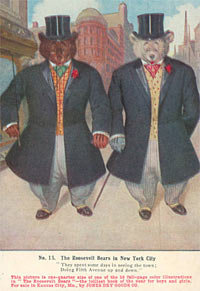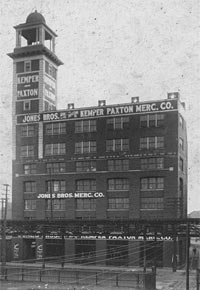On October 21, 1945 at 5:45 a.m., John Logan Jones, age 86, passed away following complications from a two-week illness. Although he was not the most celebrated of Kansas City's business leaders, Logan Jones, as he was commonly referred to, was notable for his role as co-founder of the Jones Store, which was the city's most successful department store for much of the twentieth century.
In 1859, his parents Andrew and Mary Dillon Jones were traveling by covered wagon to the frontier community of Lawrence, Kansas, where they hoped to settle. Mary Jones entered labor earlier than expected, and the family had to take refuge in a village of the Ottawa Indians near present-day Ottawa, Kansas, by the Marais des Cygnes River. Following Logan's birth on August 12, 1859, the family was finally able to settle in Lawrence. However, Civil War-related turmoil on the Missouri-Kansas border prompted the family to leave the area in May 1863, a fortuitous decision that enabled them to miss William Clarke Quantrill's infamous raid on Lawrence by just three months.
Logan then spent the rest of his childhood in Franklin County, Illinois. After several years of schooling, he followed in the footsteps of his older brother, Lawrence M. Jones, who had become a school teacher. When Logan was just 20 years old in 1879, the brothers had saved over $400 each. They used the money to open a modest general store in Parrish, Illinois. In just two years their annual revenues exceeded $30,000. Considerable success followed the brothers as they moved their business to two different Illinois locations before opening "the Cyclone" in Stafford, Kansas in 1887. Though it was their fourth business, the Stafford store was still a modest 800 square feet.
In 1890, the Jones brothers co-founded the Jones Brothers Dry Goods Company in Kansas City, Kansas. They moved again in 1895 to a site at 6th and Main in Kansas City, Missouri. Then, on the evening of Saturday, November 4, 1899, the store burned to the ground. Starting the following Monday, the company continued business out of a warehouse.
The fire led to the most important move for the Jones brothers. In 1901 they opened a massive seven-story department store at 12th and Main streets that eventually expanded to cover the entire block between 12th and 13th, and Walnut and Main Streets. As a true department store, the Jones Store Company, as it was then called, sold a variety of products. Groceries could be purchased under the same roof as stoves, hardware, blankets, home furnishings, fabrics, shoes, fine china, and various other products.
The Jones Store brand quickly gained renown in Kansas City. Logan Jones aggressively acquired merchandise from liquidated stores and then resold it to customers at reasonable prices. He used generous discounts and relentless advertising to draw customers. He even opened a bank on the first floor of the 12th and Main building as an additional convenience for the customers. A café on the third floor rounded out the services available. The Jones Store quickly became the city's largest department store. In 1902, the store already employed more than 700 workers.
Unfortunately, economic dislocations associated with the Panic of 1907 severely curtailed profits at a time that the Jones' brothers had been overextended financially. The Jones Store went bankrupt in June 1910, and was bought by a company based in New York. Under a series of different owners, however, the Jones Store brand continued to thrive in Kansas City. The retailer peaked in the 1980s with seven satellite locations in addition to the main store at 12th and Main, which was the only remaining department store in downtown Kansas City when it closed in 1998. The building was razed in 2005. In 2006, Federated Department Stores, the parent company of The Jones Store Co. re-flagged all of its locations as Macy's (which had previously operated in Kansas City from 1946 to 1986), eliminating the Jones Store name for good.
The fate of Lawrence Jones is rather obscure, but J. Logan Jones left the Jones Store in 1912 and haphazardly entered the cattle business in Texas. He failed at that experiment, and returned to Kansas City to open another small general store; the Logan Jones Dry Goods company, near 7th Street. This store enjoyed modest profits for 20 years before Logan closed it in order to retire in 1939.
When Logan Jones died in 1945, he left the Jones Store name, two novels that he wrote when dabbling in literature and poetry, and a short, but distinguished legacy as a civic reformer. Most notably in this latter role, he influenced the final location of Union Station and lobbied successfully for an expanded system of roadways and viaducts around the downtown area. With the end of the Jones Store in 2006, J. Logan Jones will likely fade into memory alongside such other long-lost Kansas City retail names as Thomas B. Bullene, W.E. Emery, Joseph Taylor Bird, William B.Thayer, and Siegmund Harzfeld.
Read a full biographical sketch of John Logan Jones, prepared for the Missouri Valley Special Collections, the Kansas City Public Library:
- Biography of J. Logan Jones (1858-1945), founder of the Jones Store, by Daniel Coleman.
View images of the Jones Store that are a part of the Missouri Valley Special Collections:
- Postcard of the Jones Store Company building; accompanied by a brief historical article.
- Postcard of 12th Street, Looking East from Main; accompanied by a brief historical article.
- Postcard of Main Street, South from 12th Street; accompanied by a brief historical article.
- Jones Store Company Café, Postcard; accompanied by a brief historical article.
- Rooftop View of Downtown; includes the Jones Dry Goods Company, 1896.
- Looking Down 12th Street, 1910.
- Jones Store Grand Opening; at 31st and Troost, 1949.
- Postcard, Jones Dry Goods Company; 1902.
- 12th Street; street view of the Jones Store, 1989.
- Christmas Postcard advertising Simplex typewriters; from the Jones Store, 1911.
- Jones Bros. Mercantile Co. building, 1908.
- Jones Dry Goods Company Booth at a fair.
- Jones Dry Goods Company house furnishings booth.
- Jones Dry Goods Company "baby check" booths.
- Jones Store; construction vew, 1957.
- Jones Store on 12th Street; taken prior to demolition, 2006.
- Jones Store at 31st and Troost; 1949 picture with crowds.
Check out the following books and articles about J. Logan Jones, held by the Kansas City Public Library:
- The Individualist, an Autobiography, by John Logan Jones.
- Sunshine and Shadow: Some Promiscuous Writings, by John Logan Jones.
- "Death of L. M. Jones: Co-Founder of Store Bearing His Name Was 89," Kansas City Genealogist, Fall 2002.
- "Keeping up with the Macy's," in the Kansas City Star, July 29, 2005; article announces that the Federated Department Stores will take over the Jones Stores and rename them "Macy's."
Continue researching J. Logan Jones using archival material held by the Missouri Valley Special Collections:
- Vertical File: Jones Store Company.
- SC63, Jones Store Company; 1911-1940s.
- "Who's Who in Kansas City," the Kansas City Star, October 29, 1922; microfilm.
- "A Department Store For Jones' Bros.," in the Kansas City Architect and Builder, November 1900; microfilm.
References:
"Big Crash in Dry Goods: Jones Company Fails in Kansas City, with $1,600,000 Liabilities," Washington Post, June 5, 1910.
Daniel Coleman, "Biography of J. Logan Jones (1858-1945)," the Missouri Valley Special Collections, the Kansas City Public Library.
George Creel and John Slavens, Men Who Are Making Kansas City: A Biographical Directory (Kansas City, MO: Hudson-Kimberly Publishing, 1902), 71.
"Department Store Burned," Chicago Daily Tribune, November 5, 1899.
"J. Logan Jones Dies," Kansas City Times, October 22, 1945.
Jennifer Mann Fuller, "Jones Founder got his Start on Kansas Plains First KC Store in the Chain Opened Downtown in 1890s," Kansas City Star, May 19, 1998.
"Large Kansas City Concern Goes into Receivers' Hands," Chicago Daily Tribune, June 5, 1910.
Sherry Lamb Schirmer, At the River's Bend: An Illustrated History of Kansas City: Independence and Jackson County (Woodland Hills, CA: Windsor Publications, 1982), 52.
Joyce Smith, "Time to Rethink Retail – Much More than the Store Name is Changing: We'll Also See a New Focus on "Affordable Luxury" Items," Kansas City Star, September 5, 2006.




